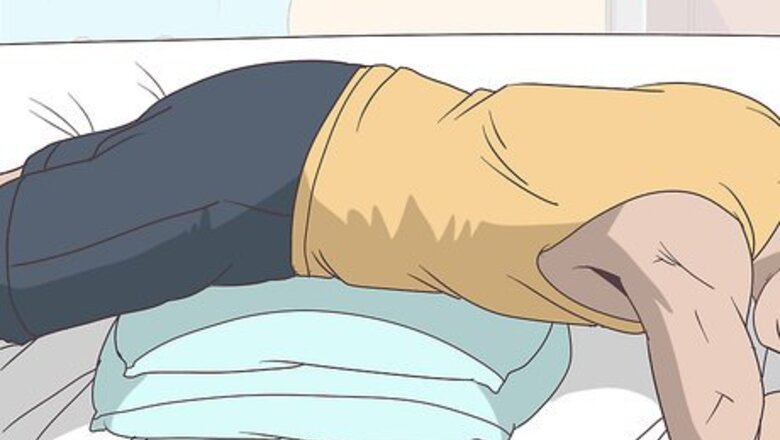
views
Using Basic First Aid
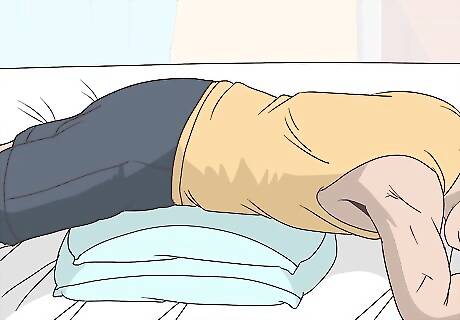
Rest with your hips propped up on pillows. Elevating your groin will help to reduce swelling and promote blood flow, which may speed up your healing. Lie on your back in bed or on a sofa and place 1 to 2 pillows under your hips so that they are above the level of your heart. Stay in this position while you’re resting. Getting plenty of rest when you’re experiencing groin pain is important. Avoid doing anything strenuous and take a day off from work or school if possible.
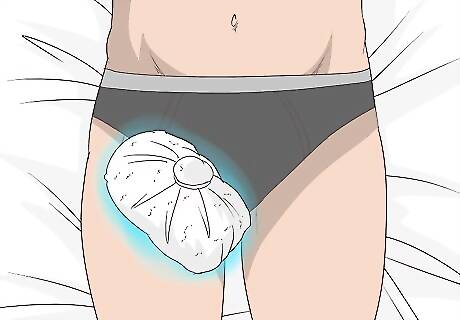
Apply an ice pack to your groin for 10-20 minutes every 1 to 2 hours. Wrap the ice pack in a thin cloth or paper towel to provide a barrier between your skin and the ice pack. Then, place the pack on your groin. Hold it there for 10 to 20 minutes and then remove it. Allow your skin to return to its normal temperature before applying the ice pack again, which takes about 1 to 2 hours. Do this for the first 3 days of your recovery after an injury or until your swelling goes down. If you don’t have an ice pack, make your own by filling a resealable plastic bag with ice cubes or use a bag of frozen vegetables, such as peas or corn.
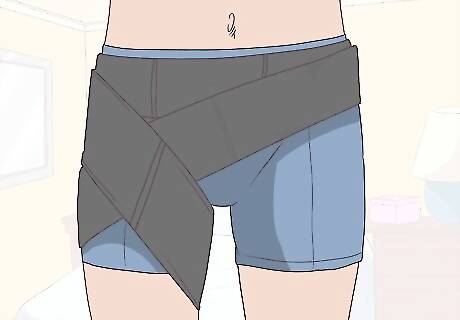
Wrap your groin or wear tight-fitting underwear to support your groin. Using an elastic wrap or wearing tight-fitting underwear will help to provide extra support in your groin area. This is especially helpful when you’re unable to rest, such as if you have to go to work or school and your groin is still hurting. Ask your doctor or a physical therapist to show you how to wrap your groin using an elastic bandage. Avoid applying the wrap too tightly or too loose or it won’t be effective.
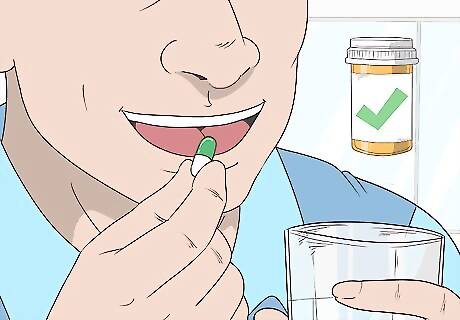
Take an over-the-counter pain reliever. Ibuprofen, naproxen, and acetaminophen are over-the-counter pain relievers that may help relieve pain in your groin area. Follow the manufacturer’s instructions for how much to take and don’t exceed the recommended dosage. Ask your doctor if you’re unsure about how much you should take. Ibuprofen and naproxen may be more effective for groin pain caused by an injury since they also reduce inflammation and swelling. However, these medications can increase the risk of stomach bleeding and ulcers.
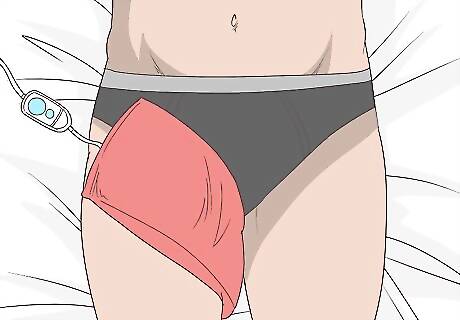
Use a heating pad 2-3 days after the injury once the swelling is gone. Heat increases blood flow to the area where you apply it, so it can be helpful for promoting healing. Wrap a heating pad in a cloth or paper towel and apply it to your groin. Leave it in place for 10 to 20 minutes and then remove it for 1 to 2 hours. Don’t use a heating pad while your injury is still fresh or swollen as this may cause swelling or make the swelling worse. Never use a heating pad while you’re asleep. This may cause your skin to become overheated or even get burnt.Tip: If you don’t have a heating pad, you can make one with an empty plastic water bottle. Fill a plastic water bottle with hot tap water, screw the cap on tightly, and wrap it in a cloth or paper towel.
Seeking Medical Attention
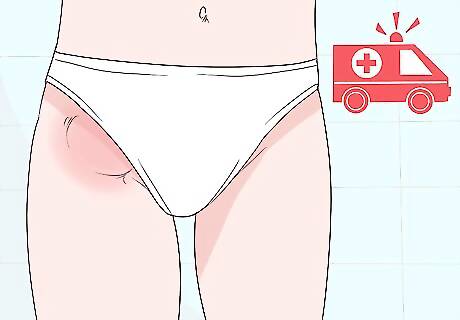
See a doctor to find out if you have a groin strain. A common cause of groin pain is a groin strain. However, groin pain may be caused by other conditions as well, so it’s important to see a doctor if you’re having symptoms and not sure why. Some common symptoms of a groin strain include: Swelling Bruising Muscle spasms Weakness Difficulty walking
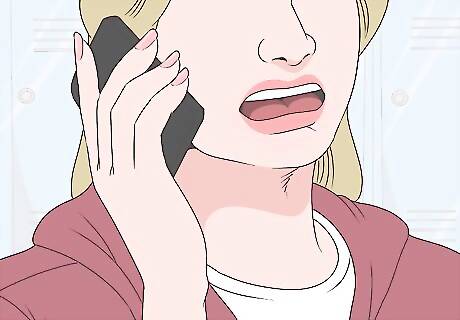
Call your doctor if the pain does not improve or if you notice new symptoms. Usually a groin strain will heal on its own within 2 to 3 weeks. However, in some cases you might need to see a doctor again, such as if your symptoms don’t improve, get worse, or you notice new symptoms. Call your doctor right away if you notice: New or worse pain or swelling in the groin area Paleness, coolness, or color changes in your groin Tingling, numbness, or weakness in your leg or groin Inability to move or put weight on your leg
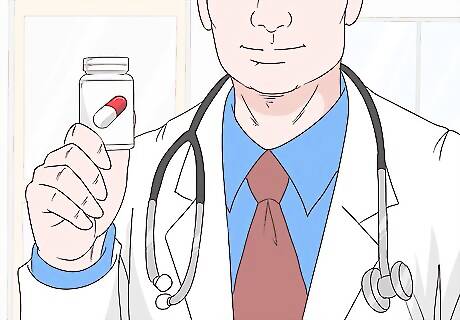
Ask your doctor about prescription painkillers if the pain is severe. If your pain is severe or chronic, over-the-counter painkillers might not be effective. Contact your doctor if your pain doesn’t go away after taking an over-the-counter painkiller. They may prescribe a stronger medication to control the pain. Commonly prescribed prescription medications that may be used to control pain include COX-2 inhibitors, antidepressants, opioids, and anti-seizure medications.Tip: Make sure to discuss the risks and benefits of any medications your doctor suggests since they are all different. For example, antidepressants can take several weeks to work and cause drowsiness, while fast-acting opioids can be addictive and put you at risk of death if you take too much.
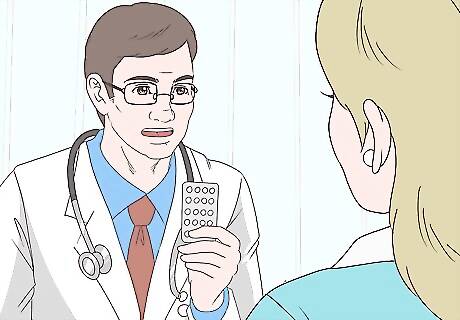
Ask your doctor about a nerve block to relieve chronic pain. A nerve block is a medical procedure that involves injecting a medication into a specific group of nerves. This blocks the pain signals in that region of your body. Discuss getting a nerve block with your doctor to manage chronic pain if other strategies have not helped. The most well-known type of non-surgical nerve block is an epidural, but there are other types that provide long-lasting relief from pain and may be helpful for groin pain, such as a peripheral nerve blockade. There are also surgical nerve blocks, including a peripheral nerve blockade, neurectomy, and rhizotomy.

Discuss surgical options to correct the problem that’s causing the pain. If your pain is ongoing and other treatment strategies have not helped, talk with your doctor about surgical options. If the pain was caused by a previous surgery, you may need another surgery to correct the problem. Surgery may also be useful for correcting pain caused by nerve damage and groin injuries in some cases. Make sure to discuss all of the potential risks and benefits of surgery with your doctor.
Trying Alternative Pain Relief Strategies
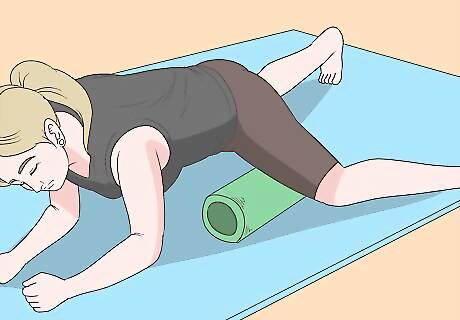
Stretch your groin muscles to relax them. Doing stretches may help to loosen tight muscles in your groin, which could be intensifying or causing your pain. Make sure to check with your doctor first if you’ve been injured to ensure that it’s safe for you to stretch. Some stretches you might try include: Using a foam roller to stretch the inside of your thigh. Doing a runner’s stretch or another hip flexor stretch. Sitting with your feet stretched out in front of you about shoulder-width apart and bending forward.
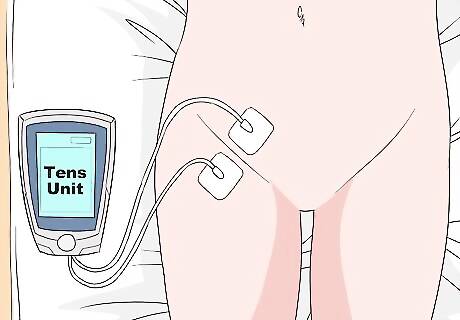
Use a TENS unit to reduce pain and relax your muscles. TENS stands for transcutaneous electrical nerve stimulation. A TENS unit is a battery-operated device that delivers a mild electrical current to a specific area of your body. This may help to relieve pain and relax your muscles by stimulating your body’s release of endorphins. Talk with your doctor if you’re interested in trying this and to get a referral to a physiotherapist.Tip: You can buy a TENS unit, but they can be expensive. If you see a physiotherapist, they may be able to temporarily loan you a machine and teach you how to use it. If it works for you, then you might consider buying your own.

Look into plasma-rich protein (PRP) injections to promote healing. This treatment involves extracting blood from your body, separating out the healing plasma in a machine, and then injecting the protein-rich plasma into your groin. This promotes faster healing, so it might be a helpful option if you were injured and your injury is not healing well. Keep in mind that this procedure won’t provide pain relief, but it may help to promote faster healing.

See an acupuncturist to treat your groin pain. Having regular appointments with an acupuncturist may help to relieve pain in your groin. They can insert special needles into areas of your body that are thought to be connected to your groin. This may help to relieve your pain and promote healing. Ask your doctor for a referral to a licensed acupuncturist, or ask friends and family for recommendations to help you choose one.



















Comments
0 comment